 W
WFlexicrurum is a genus of spiders from China similar to the genera Althepus and Leclercera. Tong and Li originally placed the genus in Ochyroceratidae, but Tong later moved it to Psilodercidae. Males are generally smaller than 2 mm, but the size of females is unknown. The name is derived from Latin flex "curved", and crur "leg", referring to the inner turned palpal tibia of the male. As of 2019 three described species have been found in caves of Hainan Island.
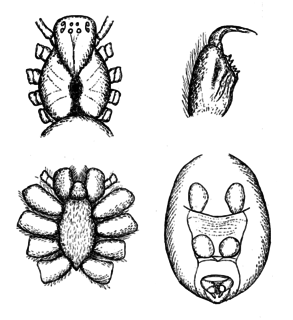 W
WHickmania is a monotypic genus of Australian cribellate araneomorph spiders in the family Austrochilidae, containing only the Tasmanian cave spider. The genus was first described by Willis J. Gertsch in 1958, and has been found only in Tasmania. It is the last of an old Gondwanan lineage, long since separated from its closest relatives in South America. It is an icon species for faunal conservation in Tasmania, and is named in honor of a professor at the University of Tasmania who specialized in spiders. The species name is derived from the Ancient Greek τρωγλοδύτης (troglodytes), meaning "cave-dweller".
 W
WThe Kauaʻi cave wolf spider, also known to local residents as the "blind spider", is only known to occur in a few caves in a lava flow with an area of 10.5 km2 (4.1 sq mi) in the Kōloa–Poʻipū region of Kauaʻi, Hawaiian Islands, and only six populations are known to exist. While their nearest surface-dwelling relatives have large eyes, this species has completely lost its eyes. They reach a body length around 20 mm (0.8 in), and are reddish brown and completely harmless to people. Unlike most wolf spiders, it produces only 15 to 30 eggs per clutch. The female carries the egg sac in her mouthparts until the spiderlings hatch.
 W
WLampshade spiders, family Hypochilidae, are among the most primitive of araneomorph spiders. There are two genera and twelve species currently recognized. Like mygalomorphs, most hypochilids have two pairs of book lungs, but like araneomorphs they have intersecting fangs, with the exception of some species which have chelicerae in an angle that is neither orthognathous or labidognathous. These long-legged spiders build typical "lampshade" style webs under overhangs and in caves. In the United States the fauna is primarily associated with the Appalachian, Rocky and California Mountains. Ten of the known species are found in these ranges, all in the genus Hypochilus. The genus Ectatosticta is found in China.
 W
WLiphistius batuensis is a species of trapdoor spider from Malaysia. It is thought to be restricted to the Batu Caves and Templer Park, near Kuala Lumpur. It was first collected by H. C. Abraham in 1923, and has been described as a living fossil.
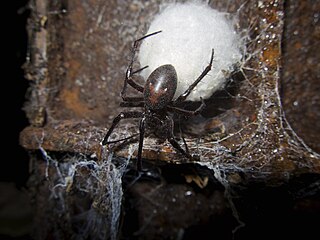 W
WMeta bourneti is an orb weaving cave spider closely related to Meta menardi.
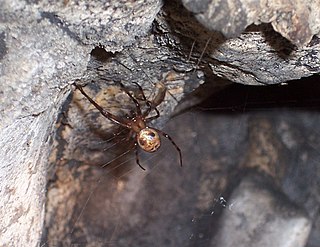 W
WMeta menardi, the European cave spider, is a long-jawed orb-weaving spider. It is also known as the orbweaving cave spider, the cave orbweaver and, in context, simply the cave spider.
 W
WOchyroceratidae is a six-eyed spider family, with 165 described species in ten genera. They are common inhabitants of caves and the tropical forest litter of South Africa, the Caribbean, Asia and South America. Considered an ecological counterpart of the Linyphiidae of the northern temperate zone, species are especially diverse in the Indo-Pacific region.
 W
WPhysocyclus globosus, sometimes known as the short-bodied cellar spider is a species of spider belonging to the family Pholcidae. This is a cosmopolitan species, found in caves and buildings throughout the warmer parts of the world.
 W
WPsechridae is a family of araneomorph spiders with about 70 species in two genera. These are among the biggest cribellate spiders with body lengths up to 2 centimetres (0.79 in) and funnel webs more than 1 metre in diameter.
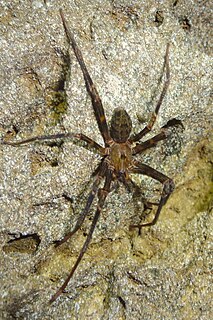 W
WThe Nelson cave spider (Spelungula) is a monotypic genus of South Pacific large-clawed spiders containing the single species, Spelungula cavernicola. It was first described by Raymond Robert Forster, Norman I. Platnick, & Michael R. Gray in 1987, and has only been found in caves in the northwestern part of New Zealand's South Island.
 W
WTartarus is a genus of spiders. All four described species are found in caves systems of Western Australia. These are located in the karst area of the Nullarbor Plain. They are likely relict species from a time when the region was much more humid, given the fact that the other members of the family Stiphidiidae in Southern Australia live in forests.
 W
WTartarus mullamullangensis, informally known as the Mullamullang cave spider, is a palm-sized, long-legged cave spider from Western Australia. Completely adapted to cave living, it is blind and totally lacks pigmentation, giving it a creamy white appearance.
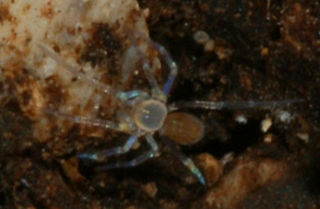 W
WThe Tooth Cave spider, formerly Neoleptoneta myopica, now Tayshaneta myopica, is a 1.6 mm long spider in the family Leptonetidae. It is endemic to limestone caves near Austin, Texas in the United States and is considered an endangered species.
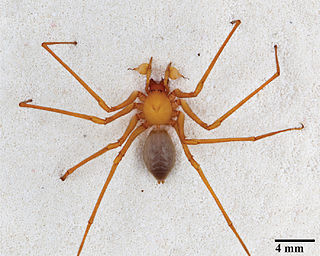 W
WTrogloraptor is a genus of large spiders found in the caves of southwestern Oregon. It is the sole genus in the family Trogloraptoridae, and includes only one species, Trogloraptor marchingtoni. These spiders are predominantly yellow-brown in color with a maximum leg span of 3 in (7.6 cm). They are remarkable for having hook-like claws on the raptorial last segments of their legs.